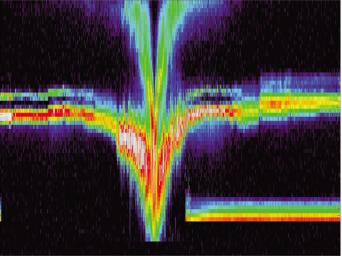
|
Comet Borrelly Slows Solar Wind
- Click the image above for a larger view
- Full-Res JPEG (640 x 480) (52.2 kB)
- Full-Res TIFF (640 x 480) (793.5 kB)
Caption:
Over 1300 energy spectra taken on September 22, 2001 from the ion and electron instruments on NASA's Deep Space 1 span a region of 1,400,000 kilometers (870,000 miles) centered on the closest approach to the nucleus of comet Borrelly. A very strong interaction occurs between the solar wind (horizontal red bands to left and right in figure) and the comet's surrounding cloud of dust and gas, the coma. Near Deep Space 1's closest approach to the nucleus, the solar wind picked up charged water molecules from the coma (upper green band near the center), slowing the wind sharply and creating the V-shaped energy structure at the center.
Background Info:
Deep Space 1 completed its primary mission testing ion propulsion and 11 other advanced, high-risk technologies in September 1999. NASA extended the mission, taking advantage of the ion propulsion and other systems to undertake this chancy but exciting, and ultimately successful, encounter with the comet. More information can be found on the Deep Space 1 home page at http://nmp.jpl.nasa.gov/ds1/ .
Deep Space 1 was launched in October 1998 as part of NASA's New Millennium Program, which is managed by JPL for NASA's Office of Space Science, Washington, D.C. The California Institute of Technology manages JPL for NASA.
Cataloging Keywords:
| Name | Value | Additional Values |
|---|---|---|
| Target | 19P/Borrelly | |
| System | Periodic Comets | |
| Target Type | Comet | |
| Mission | Deep Space 1 (DS1) | |
| Instrument Host | Deep Space 1 | |
| Host Type | Flyby Spacecraft | |
| Instrument | Miniature Integrated Camera Spectrometer (MICAS) | |
| Detector | ||
| Extra Keywords | Color, Dust, Water | |
| Acquisition Date | ||
| Release Date | 2001-11-03 | |
| Date in Caption | 2001-09-22 | |
| Image Credit | NASA/University of Michigan | |
| Source | photojournal.jpl.nasa.gov/catalog/PIA03502 | |
| Identifier | PIA03502 | |
